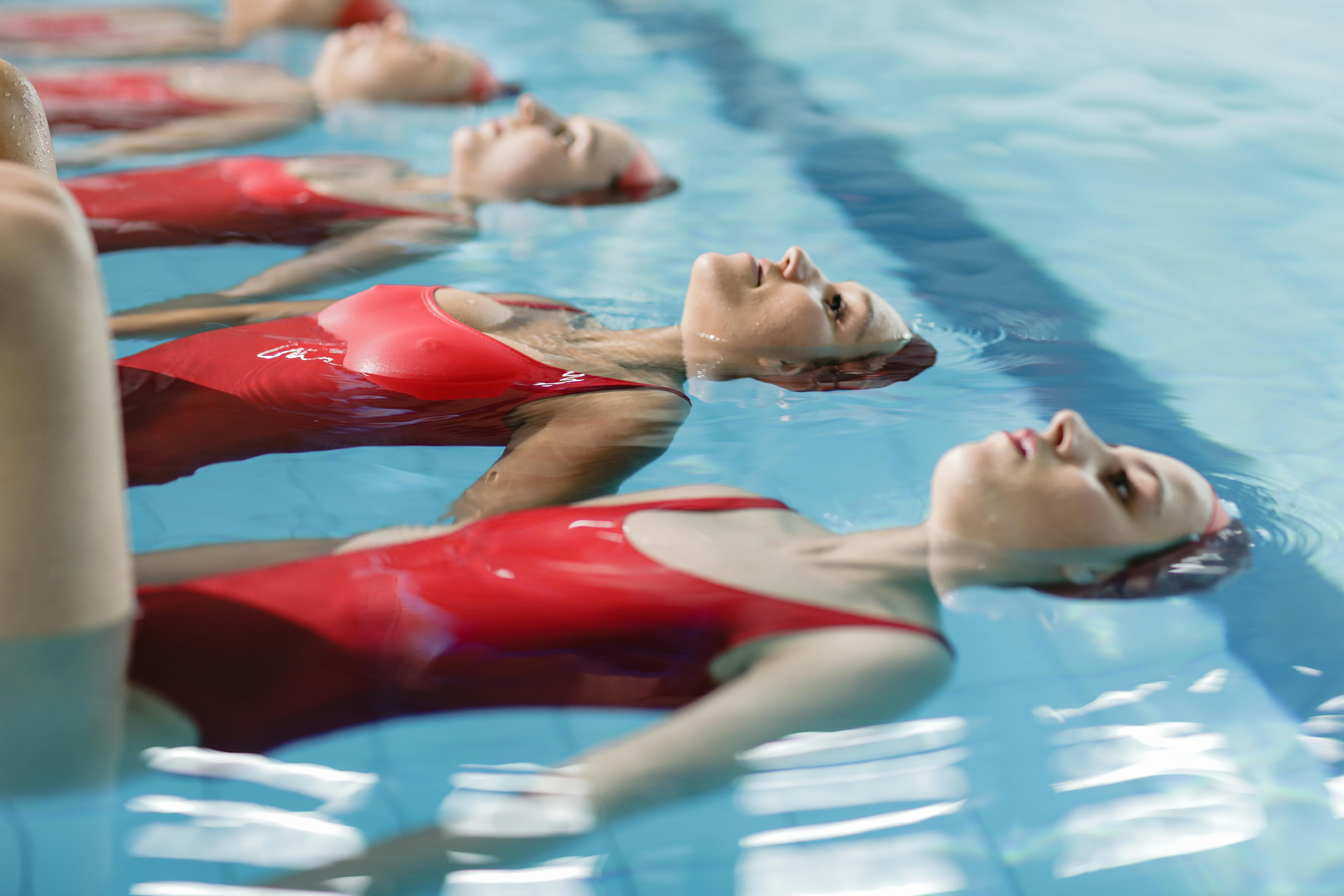The Physiological Marvels of Synchronized Swimming
Synchronized swimming, a captivating blend of artistry and athletic prowess, demands an extraordinary level of physical and mental fortitude. This intricate aquatic dance, often overlooked in the realm of competitive sports, pushes the boundaries of human physiology. From lung capacity to muscle control, synchronized swimmers exhibit remarkable adaptations that challenge our understanding of the human body's potential.

The Underwater Orchestra: Breath Control and Lung Capacity
Synchronized swimmers are the maestros of breath control, conducting an underwater orchestra with their bodies. These athletes have developed lung capacities that far exceed those of the average person, allowing them to remain submerged for extended periods while performing complex routines.
Research has shown that elite synchronized swimmers can hold their breath for up to three minutes during competition. This feat is made possible by several physiological adaptations. Firstly, these athletes undergo extensive training to increase their vital capacity – the maximum amount of air that can be exhaled after a deep inhalation. Through specialized breathing exercises and conditioning, synchronized swimmers can expand their lung volume by up to 230% compared to sedentary individuals.
Moreover, synchronized swimmers have honed their ability to efficiently use oxygen and manage carbon dioxide levels in their bloodstream. Their bodies become adept at tolerating higher levels of carbon dioxide, which allows them to suppress the urge to breathe for longer periods. This adaptation is crucial for maintaining composure and executing intricate movements underwater without surfacing prematurely.
The sport also demands exceptional control over the diaphragm and intercostal muscles. Swimmers must master the art of circular breathing, a technique that enables them to take quick, shallow breaths without disrupting their performance. This skill is particularly crucial during inverted positions, where athletes must expel water from their nasal passages while maintaining proper form.
Muscular Endurance and Strength: The Hidden Power Beneath the Surface
While the graceful movements of synchronized swimming may appear effortless, they are underpinned by extraordinary muscular strength and endurance. The sport requires a unique combination of isometric and isotonic contractions, challenging athletes to maintain static positions while simultaneously executing dynamic movements.
The core muscles, including the abdominals, obliques, and lower back, form the foundation of a synchronized swimmer’s strength. These muscles work tirelessly to stabilize the body in various positions, from vertical stands to horizontal sculling. Research has shown that elite synchronized swimmers possess core strength comparable to that of gymnasts and dancers, with significantly higher muscular endurance.
The leg muscles, particularly the quadriceps, hamstrings, and calves, are also subjected to intense demands. During vertical positions, swimmers must generate enough force to propel their bodies out of the water, sometimes reaching heights of up to 2 meters. This explosive power is coupled with the need for sustained muscle activation to maintain positions and execute precise movements.
Upper body strength is equally crucial, with the shoulders, arms, and chest muscles working in harmony to perform sculling motions and support intricate arm positions. These muscles must generate force in all directions, often against the resistance of water, requiring a level of muscular coordination that is unparalleled in many other sports.
Proprioception and Spatial Awareness: Navigating the Aquatic Arena
Synchronized swimming demands an exceptional level of proprioception – the body’s ability to sense its position and movement in space. Athletes must maintain precise body alignment and spatial awareness while submerged, often in inverted positions and with limited visual cues.
The vestibular system, responsible for balance and spatial orientation, undergoes significant adaptation in synchronized swimmers. Through repeated training, these athletes develop an enhanced ability to process information from their inner ear, allowing them to maintain equilibrium in challenging aquatic environments.
Research has shown that synchronized swimmers exhibit superior proprioceptive abilities compared to both non-athletes and athletes from other disciplines. This heightened sense of body awareness enables them to execute complex movements with remarkable precision, even when visual feedback is limited or distorted by water.
Furthermore, synchronized swimmers must develop a keen sense of timing and rhythm. The sport requires perfect synchronization between team members, often relying on subtle cues and a shared internal metronome. This temporal awareness is honed through countless hours of practice, resulting in a level of coordination that appears almost telepathic to observers.
Thermoregulation and Aquatic Adaptation: Mastering the Aqueous Environment
The aquatic environment presents unique challenges to the human body’s thermoregulatory systems. Synchronized swimmers must adapt to prolonged immersion in water, which conducts heat away from the body 25 times faster than air. This constant heat loss requires significant metabolic adaptations to maintain core body temperature.
Elite synchronized swimmers develop increased brown adipose tissue, a type of fat that generates heat through a process called non-shivering thermogenesis. This adaptation allows them to maintain body temperature more efficiently during long training sessions and performances in cool water.
Additionally, these athletes exhibit improved peripheral vasoconstriction, allowing them to redirect blood flow to vital organs and maintain core temperature even in challenging conditions. This adaptation is particularly crucial during competitions, where athletes may spend hours in the pool with limited opportunities to warm up between routines.
The sport also demands exceptional osmoregulatory control. Synchronized swimmers must maintain proper hydration and electrolyte balance despite prolonged immersion and the risk of inadvertent water ingestion. Their bodies adapt to efficiently process and excrete excess water, preventing hyponatremia – a dangerous condition caused by low sodium levels in the blood.
Cognitive Demands and Neural Plasticity: The Synchronized Swimmer’s Brain
While the physical demands of synchronized swimming are evident, the cognitive aspects of the sport are equally impressive. The brain of a synchronized swimmer undergoes significant adaptations to meet the complex demands of the discipline.
Multitasking is a fundamental requirement in synchronized swimming. Athletes must simultaneously control their breathing, execute precise movements, maintain spatial awareness, and synchronize with their teammates. This constant juggling of tasks leads to enhanced neural connectivity and improved executive function.
Research using functional magnetic resonance imaging (fMRI) has revealed increased activation in the prefrontal cortex, cerebellum, and motor cortex of synchronized swimmers during mental rehearsal of routines. These brain regions are associated with motor planning, coordination, and timing – all critical aspects of the sport.
The sport also demands exceptional memory skills. Synchronized swimmers must memorize intricate routines lasting up to four minutes, with each second choreographed in exacting detail. This mental feat requires the development of robust working memory and the ability to rapidly recall and execute complex movement patterns.
Furthermore, the aquatic environment provides a unique sensory experience that shapes neural plasticity. The altered perception of gravity, distorted visual cues, and constant proprioceptive feedback create a rich sensory landscape that challenges and reshapes neural pathways.
A Symphony of Physiological Adaptations
Synchronized swimming stands as a testament to the remarkable adaptability of the human body and mind. From the extraordinary lung capacity that allows for prolonged underwater performance to the muscular strength that defies gravity, these athletes embody the pinnacle of aquatic physiology.
The sport’s demands extend far beyond the physical realm, encompassing cognitive abilities that blur the lines between athleticism and artistry. The synchronized swimmer’s brain becomes a finely tuned instrument, capable of orchestrating complex movements with precision and grace.
As research continues to unravel the physiological marvels of synchronized swimming, we gain valuable insights into human potential. The adaptations observed in these athletes not only push the boundaries of sport but also offer implications for fields ranging from exercise physiology to neuroscience.
Synchronized swimming, often underappreciated in the pantheon of athletic pursuits, deserves recognition as a crucible of human physiological achievement. It is a discipline that challenges our understanding of what the body can accomplish and serves as a vivid reminder of the extraordinary capabilities that lie within us all.




